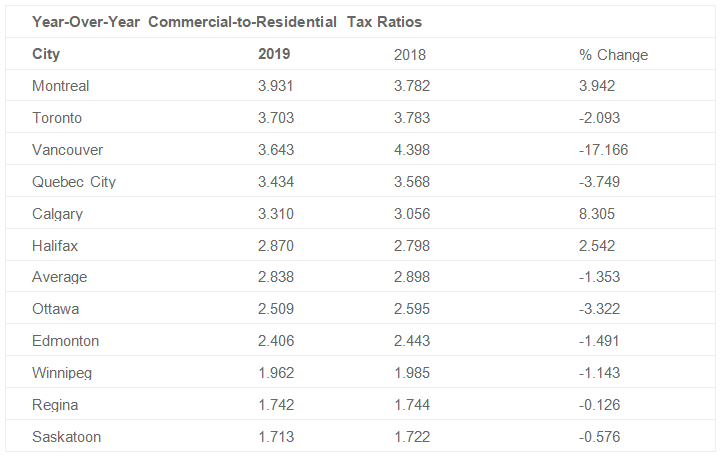Canadian businesses continue to face a disproportionate property tax burden according to a new report.
In 8 of the 11 cities studied by Altus Group, commercial property tax is at least double that of residential properties with Montreal, Toronto, and Vancouver continuing to have the highest commercial-to-residential ratios in the country.
But the survey found that Calgary and Montreal posted the largest increases in the commercial-to-residential ratio in 2019.
“Despite seeing some major shifts this year, the commercial-to-residential tax ratio is still an issue of relative fairness as we continue to see several cities across Canada shifting the burden of property taxes to business owners,” said Terry Bishop, President of Property Tax Canada at Altus Group. “Expecting businesses to shoulder the same burden while values decline, or taxes increase beyond business growth, is unsustainable. Measures that compress the gap between residential and commercial tax rates are positive steps that can help the viability of all businesses.”

Market-By-Market Trend Analysis
- Montreal’s commercial-to-residential tax ratio first rose above the average in 2008 and has been steadily climbing since, now sitting at 3.93, the highest of all of the cities surveyed.
- Toronto continues an eleven-year trend of lowering commercial rates with a decrease of 5.29%; however, it maintains the second highest commercial-to-residential tax ratio.
- For the first time in 20 years, Vancouver posted a commercial-to-residential tax ratio below 4:1, with a decrease of 17.17%, the largest decline of all 11 cities surveyed. This is attributed to a decrease of 14.05% in the commercial tax rate combined with a modest increase of 3.76% in the residential tax rate.
- Quebec City’s commercial-to-residential tax ratio is the fourth highest of all cities surveyed. It has been steadily climbing for 15 years; however, it decreased by 3.75% this year.
- For the second consecutive year, Calgary saw the largest ratio increase of all 11 cities at 8.31%. Calgary also saw the largest increase in commercial tax rates for the fourth year in a row, jumping by 13.36% in 2019, representing a 55% overall increase in Calgary’s commercial tax rate over the last four years.
- Halifax’s commercial-to-residential tax ratio has remained relatively stable since 2006 but has slowly been increasing over the past few years. It now sits above the average for the first time in six years.
- Ottawa’s commercial-to-residential tax ratio of 2.51, sits just below the average ratio for the 10th consecutive year.
- Edmonton sits just below the average with a ratio of 2.41 and has remained relatively stable over the last four years.
- Although Winnipeg’s ratio has remained fairly stable for three years, it posted the highest 2019 residential rate at $12.33, an increase of 1.76% from last year.
- Regina remains quite stable posting a 1.74 commercial-to-residential tax ratio, with only slight increases in both commercial and residential tax rates in 2019.
- Saskatoon continues to show the lowest commercial-to-residential tax ratio at 1.71, a slight decrease from last year.



